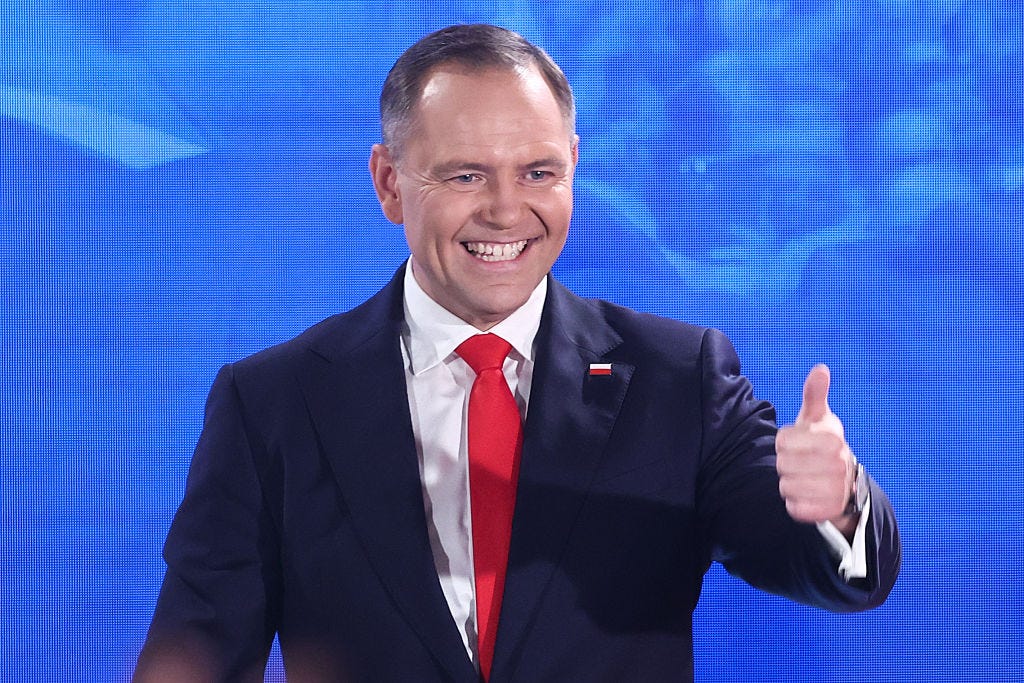
This article is brought to you by American Purpose, the magazine and community founded by Francis Fukuyama in 2020, which is proudly part of the Persuasion family.
The second round of the Polish presidential election just took place on June 1, 2025. It was won by Karol Nawrocki, who gained 50.9% of the vote against Rafał Trzaskowski, the mayor of Warsaw, who gained 49.1%. The office of the president is largely ceremonial in Poland, yet this election was critical for at least three reasons.
Judicial reforms will be delayed for at least five years.
The Law and Justice Party (PiS) formed the government in Poland from 2015 to 2023, during which time they placed their allies on the Constitutional Tribunal, named 3,000 judges (the so-called “neo-judges”) without following the usual procedure, fused the Attorney General’s office with the Ministry of Interior, and introduced a disciplinary chamber that would presumably punish disloyal judges. All of this was in violation of both internal and European court rulings.
The next government under the Civic Platform (PO) party, elected in 2023, began to undo these moves. The disciplinary chamber is gone, as is the politicization of the judiciary. However, further moves in that direction require parliamentary legislation—and outgoing president Andrzej Duda, affiliated with PiS, has consistently vetoed reform legislation, or sent it to the Constitutional Tribunal (filled with PiS appointees) for an indefinite “consultation.”
Now, president-elect Karol Nawrocki, a PiS loyalist whose past stints included a position as a historian in the Institute of National Remembrance, is likely to continue the vetoes. Moreover, since parliamentary elections must take place in 2027 at the latest, he has every incentive to stymie the legislative agenda of the ruling PO coalition to ensure that PiS returns to power. Had he won, Trzaskowski, a PO politician, would have pursued a very different path.
Polish politics are both polarized and not polarized.
On the one hand, Nawrocki’s candidacy succeeded in the face of numerous personal scandals: he was accused of buying the apartment of the 80-year-old man for whom he was a legal guardian, despite earlier denials, and of procuring prostitutes when he worked as a security agent at a luxury seaside hotel. His past included fighting as a soccer hooligan (a charge he never denied) and alleged connections to gangs.
Yet despite these charges, his supporters did not desert him, and in fact there is reason to think that much like President Donald Trump in the United States, some of his voters supported him because of, rather than despite, this record. Far-right voters, who had earlier supported highly controversial candidates such as the neo-fascist Grzegorz Braun (infamous for his anti-semitism) and the far-right Sławomir Mentzen of the Konfederacja party, overwhelmingly supported Nawrocki.
On the other hand, both PO and PiS are right-wing parties: the main difference is that PO is committed to the rule of law and the democratic process, while PiS is a populist party with a very different understanding of executive constraints. The Polish political spectrum leans right: Left-wing parties are small and unpopular (they hold roughly 5% of parliamentary seats) compared to PO, PiS, and the far-right Konfederacja. In this election, the electorate behaved as it always has: older, more religious, and more rural voters supported Nawrocki and PiS, while younger, secular, more educated, and urban voters supported Trzaskowski and PO. (This time, Trzaskowski’s poorly-run campaign may have mattered more than anti-democratic sentiment.)
Both PO and PiS appear smug and unresponsive to younger voters—the demographic critical to the future of Polish democracy.
The turnout of 18 to 29-year-olds was crucial to PO’s victory in 2023 and the return of the rule of law to Poland. At the same time, these voters are sick and tired of the POPis duopoly (the neologism means “display” or “exhibition” in Polish). In the first round of the election, on May 18, voters in the 18-29 age group supported Mentzen of the far-right Konfederacja, and the left-wing politician Adrian Zandberg, with Nawrocki and Trzaskowski only getting between 10 and 12% each in this age group.
Here, we see a similar split to the one occurring elsewhere in democracies: young women supported the left-wing Zandberg, while young men supported the far-right Mentzen. Overall, these voters are strong supporters of democracy, but they feel excluded from mainstream politics and its complacent governance. They want politicians to pay far more attention to issues such as the high cost of housing or the availability of credit and investment. Yet neither PO nor PiS has articulated a set of policies that would address their needs.
Even as Poles remain overwhelmingly in support of democracy and European integration, they are as divided as other democracies between populism and liberalism. And Poland, too, faces the critical issue of mainstream parties that govern—and disappoint.
Anna Grzymala-Busse is the Michelle and Kevin Douglas Professor of Political Science at Stanford University, a Senior Fellow at the Freeman Spogli Institute, and the Director of the Europe Center at Stanford.
Follow Persuasion on Twitter, LinkedIn, and YouTube to keep up with our latest articles, podcasts, and events, as well as updates from excellent writers across our network.
And, to receive pieces like this in your inbox and support our work, subscribe below:





"All those angry young men"